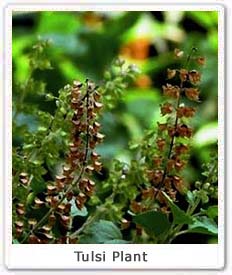| Kingdom : | Plantae |
| Division | Magnoliophyta |
| Class: | Magnoliopsida |
| Order : | Lamiales |
| Family : | Lamiaceae |
| Genus : | Ocimum |
| Species : | O. tenuiflorum |
| Scientific Name : | Ocimum Sanctum |
| Found In : | Gir National Park and Sasangir National Park |
Other names : It is known as Holy Basil in English and Tulasi in Sanskrit. Other names used for the Tulsi are Manjari, Krishna Tulsi, Trittavu, Tulshi and Thulsi.
Description : Tulsi is a heavy branched having hair all over. It attains the height of about 75 – 90 cm. It has round oval shaped leaves which are up to 5 cm long. The leaves are 2- 4 cm in length. Its seeds are flat. Its flowers are purple – creamish in colour. The Tulsi with the green leaves is called the Shri Tulsi and one with the reddish leaves is called the Krishna Tulsi. Its seeds are yellow to reddish in colour. Leaves of Tulsi contains very essential oil.

Other species : Ocimum canum (Ram tulsi or Kali Tulsi), Ocimum basilicum, Ocimum Kilmand, Ocimum scharicum are the other related species of the Tulsi (Ocimum Sanctum).
Location : Tulsi is widely grown in the Gir Wildlife Sanctuary and Sasangir National Park in India. Tulsi grows wild in tropics and warm regions.
Cultivation methods : Tulsi seeds germinate easily. The seeds are mainly sown in the spring season. They are watered from time to time and germinated in one to two weeks. Tulsi prefers rich soil for its growth. It requires full sunlight. It is mainly grown in the temperate climate.
Medicinal uses : Tulsi has got the great medicinal value. Tulsi is taken as the herbal tea. The oil extracted from the Karpoora Tulsi is mostly used in the herbal toiletry. Its oil is also used against the insects and bacteria. The Rama Tulsi is the effective remedy for the Severe acute Respiratory Syndrome. Juice of its leaves gives relief in cold, fever, bronchitis and cough. Tulsi oil is also used as the ear drop. Tulsi helps in curing malaria. It si very effective against indigestion, headache, hysteria, insomnia and cholera. The fresh leaves of Tulsi are taken by the million of people everyday. For over the centuries Tulsi (the queen of herbs) has been known for its remarkable healing properties.
Other uses : Many people wears the Tulsi beads, which is said to have certain physical and medicinal properties. Its wood is considered as more powerful than any other gem that helps in protecting one from the negative influences. One can also buy several handicraft jewellery items made of Tulsi wood.
Cultural Importance : Tulsi is the sacred plant dearer to the Lord Vishnu. Tulsi symbolises purity. It is considered as the holy plant in the Indian Subcontinent. Tulsi got its name from Tulasi Devi, who was one of Lord Krishna's eternal consorts. In India people grow Tulsi as the religious plant and worship it. Its leaves are used in temples for the worship purposes and also on the several occasions such as marriage. A Hindu house is considered incomplete without the Tulsi plant in the courtyard. Tulsi is belived to promote longevity and life long happiness. Hindus perform special Tulsi puja in the Kartik month which starts after Sharad Poornima. It is the time of the Tulsi vivah (marriage). On this day Tulsi is decorated and coloured as a bride.Even today people in India maintain a potted Tulsi plant. The womens water the plant, light up the diya near it and worships it daily. The stems, leaves, seeds and even the soil is considered as holy. According to the ancient texts Tulsi is glorified as the one who helps in bringing people closer to the divine.






